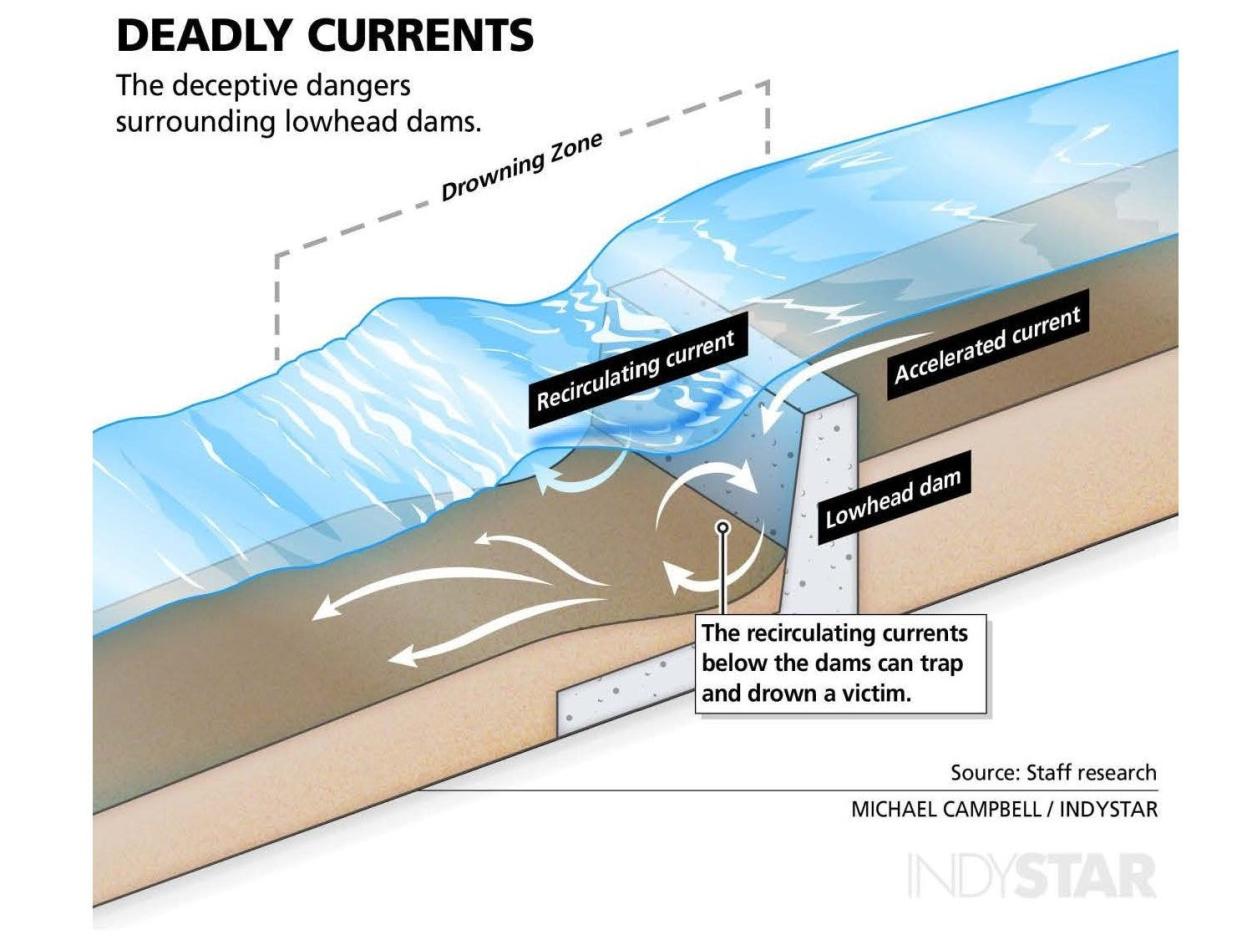Indy to remove low-head dam on White River where two kayakers drowned in April
The Emrichsville Dam on the White River at Belmont Beach, one of more than 90 dangerous low-head dams across Indiana, will be removed with funds from a $750,000 federal grant.
Low-head dams, like Emrichsville, are extremely dangerous to Hoosiers enjoying time out on the water. The deaths of two kayakers who drowned after their boats capsized going over the dam April 16 was a stark reminder of the risks these structures pose.
Scott Salmon, executive director of Friends of the White River, said these structures create sort of a sideways whirlpool that recirculates water at the dam's base rather than flushing it downstream. The phenomenon is similar to how an ocean’s rip tide can pull people underwater and away from shore.

“It’s a water current that you cannot overcome with human power, with paddles or swimming your hardest,” Salmon said. “Nature wins that fight every time.”
Where did the Emrichsville dam removal money come from?
The U.S. Fish and Wildlife Service awarded Indy $750,000 through it’s National Fish Passage Program to Indy’s Department of Public Works to restore the river’s ecosystem and create safe passage for Hoosiers recreating on the water.
The funding is part of a larger effort of the Department of the Interior’s Secretary Deb Haaland to improve fish passage throughout the U.S. while strengthening local economies, increasing recreational activities and bolstering climate resilience.
The grant money will help Indy cover some of the removal design, the city’s stormwater administrator, Shannon Killion, said. The city will go through the design process, obtain permits and then begin a bidding process before removal begins.
Low-head dams are deadly: Body of second missing kayaker recovered in White River
Low-head dam safety in Indiana
Indiana has a little more than 90 low-head dams throughout the state built for various reasons. Some dams were put up by power plants that needed extra water for cooling, while others provided municipalities with a fresh drinking water source.
Hoosiers out for a paddle should plan ahead to make sure their voyage doesn’t cross over any low-head dams, or know when to get out of the water and portage around the dam.
Capt. Jet Quillen, with DNR’s Law Enforcement Division, puts it simply: “Stay away from them.”
“If you’re going in a canoe, kayak or boat: create a float plan,” Quillen said. “Know where you’re going to go in and where you’re going to take out. Make sure people are aware of where you’re going and when you will be home, too.”
Paddlers and swimmers need to exit a “great distance” upstream of a low-head dam and re-enter the water well below them, Quillen said.
Drowning deaths in Indiana
Everyone enjoying the water is out to have fun and awareness levels may be low, Quillen said, Hoosiers need to be aware of the dangers that water poses.
Indiana averages around 49 drownings each year, according to figures provided by DNR, and one of the main things Quillen tries to hit when speaking about water safety is that everyone should wear a lifejacket.
“The comments we used to always hear were that lifejackets are too bulky and too hot,” Quillen said. “But lifejacket design has come a long way in last 10 years and you can buy more streamlined, cooler, better fitting, not as bulky life jackets.”
Keeping everyone in your group aware of the risks and making sure lifejackets are available are the essentials of any day on the water.
The Indiana Department of Health looked at drownings across the state from 2018-2021 and found 216 people died. Some highlights of the report include:
77% of deaths were people aged 18 or older
29– to 37-year-olds were the largest single age group to drown
33 drownings were kids 10 and under
79% of drownings were male
80% (more than 170 deaths) occurred in rivers, creeks and streams
50 swimmers died, making it the most common cause
21 boating accidents, 9 kayaking and 4 canoeing caused drownings
Low-head dam removal also improves ecosystems
Removing dams creates a safer space for Hoosiers out on the water, but also provides better habitat for fish and other aquatic life. A large majority of fish in Indiana’s rivers and streams need to move up and downstream throughout their lives, and these dams block that natural movement.
Jerry Sweeten, with Ecosystems Connections Institute, said there is a huge movement in the U.S. to remove low-head dams for ecological restoration, and the benefits of removal happen quickly.
Pooling behind a low-head dam does not support fish populations very well, but within a year of dam removal, data shows these sites support fish just as well as sites that never had dams, Sweeten said.
“In a lot of things in restoration, we don’t see response from the system for some time depending on what it is,” Sweeten said. “Removing a low-head dam is one of the very best and most expedient things we can do to restore the function of streams. It happens almost immediately.”
Karl Schneider is an IndyStar environment reporter. You can reach him at karl.schneider@indystar.com. Follow him on Twitter @karlstartswithk
IndyStar's environmental reporting project is made possible through the generous support of the nonprofit Nina Mason Pulliam Charitable Trust.
This article originally appeared on Indianapolis Star: Indy to remove White River low-head dam after federal funding
